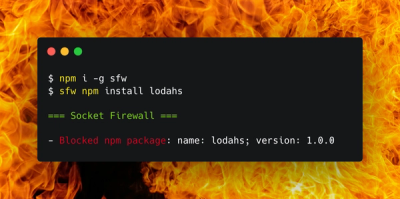
Security News
PodRocket Podcast: Inside the Recent npm Supply Chain Attacks
Socket CEO Feross Aboukhadijeh discusses the recent npm supply chain attacks on PodRocket, covering novel attack vectors and how developers can protect themselves.
react-markdown-with-shortcodes
Advanced tools
Renders Markdown as pure React components.
Demo available at https://rexxars.github.io/react-markdown/
react-markdown is proudly sponsored by

npm install --save react-markdown
const React = require('react')
const ReactDOM = require('react-dom')
const ReactMarkdown = require('react-markdown')
const input = '# This is a header\n\nAnd this is a paragraph'
ReactDOM.render(
<ReactMarkdown source={input} />,
document.getElementById('container')
)
If you don't need to render HTML, this component does not use dangerouslySetInnerHTML at all -
this is a Good Thing™.
Inline HTML is currently broken for any tags that include attributes. A vague idea of how to fix this has been planned, but if you're feeling up to the task, create an issue and let us know!
source - string The Markdown source to parse (required)className - string Class name of the container element (default: '').escapeHtml - boolean Setting to false will cause HTML to be rendered (see note above about
broken HTML, though). Be aware that setting this to false might cause security issues if the
input is user-generated. Use at your own risk. (default: true).skipHtml - boolean Setting to true will skip inlined and blocks of HTML (default: false).sourcePos - boolean Setting to true will add data-sourcepos attributes to all elements,
indicating where in the markdown source they were rendered from (default: false).allowedTypes - array Defines which types of nodes should be allowed (rendered). (default: all
types).disallowedTypes - array Defines which types of nodes should be disallowed (not rendered).
(default: none).unwrapDisallowed - boolean Setting to true will try to extract/unwrap the children of
disallowed nodes. For instance, if disallowing Strong, the default behaviour is to simply skip
the text within the strong altogether, while the behaviour some might want is to simply have the
text returned without the strong wrapping it. (default: false)allowNode - function Function execute if in order to determine if the node should be allowed.
Ran prior to checking allowedTypes/disallowedTypes. Returning a truthy value will allow the
node to be included. Note that if this function returns true and the type is not in
allowedTypes (or specified as a disallowedType), it won't be included. The function will
receive three arguments argument (node, index, parent), where node contains different
properties depending on the node type.transformLinkUri - function|null Function that gets called for each encountered link with a
single argument - uri. The returned value is used in place of the original. The default link URI
transformer acts as an XSS-filter, neutralizing things like javascript:, vbscript: and file:
protocols. If you specify a custom function, this default filter won't be called, but you can
access it as require('react-markdown').uriTransformer. If you want to disable the default
transformer, pass null to this option.transformImageUri - function|null Function that gets called for each encountered image with a
single argument - uri. The returned value is used in place of the original.renderers - object An object where the keys represent the node type and the value is a React
component. The object is merged with the default renderers. The props passed to the component
varies based on the type of node.
text, the value should be a function that takes the literal text and returns a new string or React element.The node types available are the following, and applies to both renderers and
allowedTypes/disallowedTypes:
root - Root container element that contains the rendered markdowntext - Text rendered inside of other elements, such as paragraphsbreak - Hard-break (<br>)paragraph - Paragraph (<p>)emphasis - Emphasis (<em>)strong - Strong/bold (<strong>)thematicBreak - Horizontal rule / thematic break (<hr>)blockquote - Block quote (<blockquote>)delete - Deleted/strike-through (<del>)link - Link (<a>)image - Image (<img>)linkReference - Link (through a reference) (<a>)imageReference - Image (through a reference) (<img>)table - Table (<table>)tableHead - Table head (<thead>)tableBody - Table body (<tbody>)tableRow - Table row (<tr>)tableCell - Table cell (<td>/<th>)list - List (<ul>/<ol>)listItem - List item (<li>)definition - Definition (not rendered by default)heading - Heading (<h1>-<h6>)inlineCode - Inline code (<code>)code - Block of code (<pre><code>)html - HTML node (Best-effort rendering)Note: Disallowing a node will also prevent the rendering of any children of that node, unless the
unwrapDisallowed option is set to true. E.g., disallowing a paragraph will not render its
children text nodes.
git clone git@github.com:rexxars/react-markdown.git
cd react-markdown
npm install
npm test
MIT © Espen Hovlandsdal
FAQs
Renders Markdown as React components
The npm package react-markdown-with-shortcodes receives a total of 0 weekly downloads. As such, react-markdown-with-shortcodes popularity was classified as not popular.
We found that react-markdown-with-shortcodes demonstrated a not healthy version release cadence and project activity because the last version was released a year ago. It has 1 open source maintainer collaborating on the project.
Did you know?

Socket for GitHub automatically highlights issues in each pull request and monitors the health of all your open source dependencies. Discover the contents of your packages and block harmful activity before you install or update your dependencies.

Security News
Socket CEO Feross Aboukhadijeh discusses the recent npm supply chain attacks on PodRocket, covering novel attack vectors and how developers can protect themselves.

Security News
Maintainers back GitHub’s npm security overhaul but raise concerns about CI/CD workflows, enterprise support, and token management.

Product
Socket Firewall is a free tool that blocks malicious packages at install time, giving developers proactive protection against rising supply chain attacks.